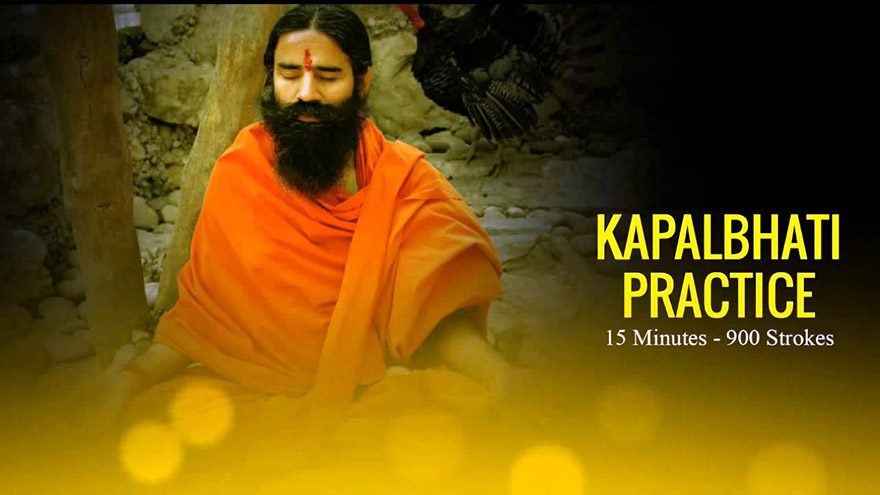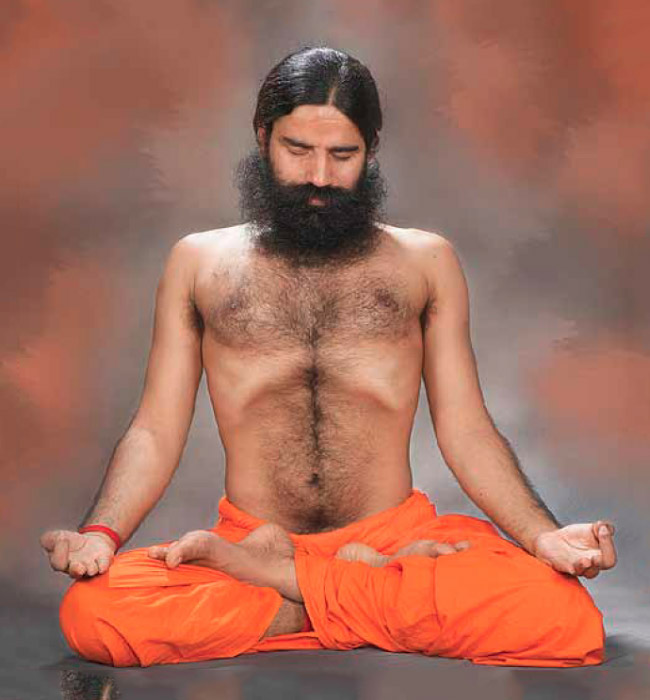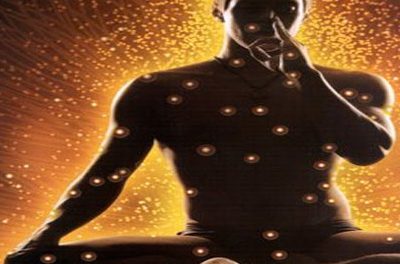Kapalbhati is a yogic respiratory technique, which has been described in yogic texts. Its practice is done with an increase in the rate of respiration, which includes active (voluntary) respiration (with the contraction of the abdominal muscles) and inactive (involuntarily) breathing (exercise of abdominal muscles).
For the practice of Kapalbhati, the practitioner should sit in padmasana, siddhasana or sukhasana, keeping the spinal cord and head straight. The practitioner should close their eyes and keep focus on the breathing process.
In the traditional yogic texts special mention of the Kapalbhati practice is found. In Gherand Samhita 3 different categories of Kapalbhati have been described.
1) Vata Krama – In the process, breathing is taken from the left nostril and released from right nostril. In second step, breath is taken from right nostril and released from the left nostril.
2) Vyut Krama – Vyut Krama Kapalbhati is being practiced with water being sucked from both the nostrils and released from the mouth, slowly.
3) Bheet Krama – In this process, water is taken in from the mouth and released from both the nostrils.
[wp_ad_camp_1]
The practice of Kapalbhati, mentioned in the Gherand Samhita has described various health benefits. The body turns flexible and healthy and the `kapha` disorders are treated. For people who perform Kapalbhati, old-age related disorders remain at arms length from them. Other traditional yoga books like Hatha Yoga Pradeepika also describe similar benefits. Keeping the benefits of yoga as mentioned in the ancient books, when scientific research was performed with the help of modern equipments, the scientists got the following results.
Heart Related Affect
This is a well-known fact that our heart beat reverberation fluctuates, according to the need. When we run fast, the heart beat also speeds up. The reason behind this is to fulfill the need of the muscles; heart has to send more blood to different parts of the body. When we rest, after fast running, the heart beat turns normal. The autonomous nervous system plays an important role in amending the speed of the heart beats. With the activity of resonating nervous system, the heart beat goes up and with the activity of de-resonating nervous system, it goes down. Heart Rate Variability (HRV) is a standard of measuring the autonomous nervous system.
The impact of Kapalbhati was studied on Heart Rate Variability, which found that after the practice of Kapalbhati (respiration rate 60 per minute) there remains no resonating activity, with no tension on the heart. According to bio-psychosocial Medicine 2011, 5:4, the result shows that the people who have grown older and affected of high blood pressure or under the risk of heart related diseases may perform Kapalbhati (respiration rate 60 per minute) without additional pressure to their heart.
Consumption of Energy
Obesity is a common problem in the world. The main reason behind obesity is the imbalance of getting energy from the edibles and burning the energy with mental and physical actions. Oxygen is a very important factor in energy expenditure, which helps in energy burning. The more the consumption of oxygen, the more there is burning of energy (taken from the food). To identify how Kapalbhati helps in the consumption of energy an experiment was performed on healthy employees. According to Medicine Science Monitor Basic Research 2015 21:161-171, it was found that during Kapalbhati, the consumption of oxygen increases by 30%. The conclusion was drawn that in the practice of Kapalbhati, the energy consumption increased by 42% and hence, it is beneficial in reducing obesity.
Mental Health
For the healthy and peaceful life, a good mental health is needed. A person having better concentration efficiency and memory is more successful in life as compared to those who have not. With the help of equipment – which is being utilized to study the impact of Kapalbhati on concentration or meditation – a study was performed.
Evoked potential is one of the equipments, utilized to measure the concentration level.
While using this equipment, a practitioner is asked to concentrate on a particular voice and during the process; the activity of the brain regions is watched. The information gathered include 1) efficiency of nervous cells and 2) the concept of the amount of nervous cells which are being utilized during meditation activity. According to the Journal of Alternative And Compliments Medicine 2009, 15:281:285, it was established that those who practice Kapalbhati may increase their nervous cells efficiency. Their mental efficiency increases as compared to those who do not.
Thus, Kapalbhati is a great exercise for everyone, improving our health both physically and mentally. Those who have epilepsy, abdominal surgery, heart ailments and uncontrolled high blood pressure should practice it carefully.











Is it harmful to do kapal bhatti after breakfast .
Hi
The description of kapalabhati seems so different from what is practiced. Even Babs Ramdev version is different
Baba teaches to exhale air.
Breathing from onr nose and releasing from other is anulom vilom.
Please confirm if your article is right.
how long kapalbhati should be performed?
Thanks for giving practical demonstration of Baba Ramdevji’s technique of doing “Free of cost” Kapaal Bhaati and details of its benefits.
B K DHIR
I am 64 years old man.Have Enlarged Prostate since last five years.I do kapalbhati,pranayam,veg diet and exercise.life is continueing .
How long it will take to reduce size ogf Prostate with Kapalbhati?
Kalahari is sanjeevini
Kapalabati is Sanjeevini, which activates Kundilini
rama is saving this generation i suppose through you,see to that no body comes your way and disturb.you are almost attracting through your good deeds 50 to 60 crore people.
baba ram dev ji,take care of your health .what you did for the past 30years.now more you shouldd do to human beings. .
I was a sceptic ( I am a retired research biologist)all what was told by my teacher
When I was 70 a friend insisted I should try to reduce my stress
Filled life
I tried the Yoga for a laugh I am now 80 (yes 80 look around60)
I have stoppe laughing and thank the Indian Science of yoga
Nameskarams for you all Thank you very much for this information to put to use in our normal life
One should practice this pranayam patiently and increase its time length baba gi has given us this practice through his experience so one should not have a slightest doubt, it’s got very positive benefits, I myself have been practicing it for over 5 years now, I suffer from epilepsy, but I haven’t had a attack for over 5years and also my medication has been reduced thanks to baba gi.
The description given in article for Kapalbhati is not correct. This is anulom vilom and Jal Neti. There is some editing from with the article. Please post the correct article.
I have been practicing kapalbathi for about a year and I find so much improvements in health. I usually do 60 counts of 7 sets.
I agree with Ms Vijayalakshmi’s comment (Aug 6) – Baba Ramdev’s method -just exhalation is kapalbhati I have beeen taught.